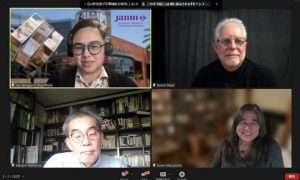Photos tell story of LA and Hiroshima: U.S. Japanese American National Museum holds online event to explain Wakaji Matsumoto’s photos
Dec. 26, 2022
by Kyoko Niiyama, Staff Writer
An online event was held at the end of last year, 2022, to trace the historic significance of a large volume of photographs that Wakaji Matsumoto, who died in 1965 at the age of 76, took in Los Angeles after his immigration to the United States as well as in Hiroshima before the atomic bombing. The Japanese American National Museum in Los Angeles has posted on its publicly available website about 80 photos taken by Mr. Matsumoto during the period 1917–1944. The event was held as a kind of gallery talk for what the museum calls an online exhibition of Mr. Matsumoto’s work.
A total of 52 people from Japan and the United States participated in the online event. Dennis Reed, 76, the museum’s curator, explained that Mr. Matsumoto improved his photography skills as a member of a Japanese-American group of photographers while he worked as a farm laborer in and around Los Angeles during the 1920s. Mr. Reed added that Mr. Matsumoto had not only recorded the lives of immigrants working as farm laborers but had also enthusiastically developed his skills as an artistic photographer.
The number of his photos in the exhibition taken of Hiroshima totaled 45. Those photos capture the cityscapes of Hiroshima and the lives of local people including their facial expressions prior to the atomic bombing of the city. One panoramic photo of Aioi Bridge and its vicinity that he took in 1938 and is now on display at the Hiroshima Peace Memorial Museum (in the city’s centrally located Naka Ward) shows details of that area at the hypocenter. Masami Nishimoto, 66, former staff writer at Chugoku Shimbun is steeped in knowledge about Mr. Matsumoto’s work. “That one photo conveys the story of people’s daily lives, which were wiped out in the atomic bombing, and asks us to consider how we should live in the future.”
Mr. Matsumoto was born in the village of Jigozen (now part of Hatsukaichi City, Hiroshima Prefecture) and immigrated to the United States in 1906. After he returned to Hiroshima in 1927, he opened a photo studio near the major intersection in the present-day Kamiya-cho (part of Hiroshima’s Naka Ward). Closing the studio in 1942, he had moved the prints of his photos elsewhere, meaning that the materials escaped damage from the fires that arose after the atomic bombing in the hypocenter area. His photos are now stored at the Hiroshima City Archives, in the city’s Naka Ward. Karen Matsumoto, 69, Mr. Matsumoto’s granddaughter who lives in the U.S. state of Washington, explained that sharing her grandfather’s photos provided her with the chance to consider the devastation caused by the atomic bombing and the current situation surrounding nuclear weapons.
(Originally published on December 26, 2022)
An online event was held at the end of last year, 2022, to trace the historic significance of a large volume of photographs that Wakaji Matsumoto, who died in 1965 at the age of 76, took in Los Angeles after his immigration to the United States as well as in Hiroshima before the atomic bombing. The Japanese American National Museum in Los Angeles has posted on its publicly available website about 80 photos taken by Mr. Matsumoto during the period 1917–1944. The event was held as a kind of gallery talk for what the museum calls an online exhibition of Mr. Matsumoto’s work.
A total of 52 people from Japan and the United States participated in the online event. Dennis Reed, 76, the museum’s curator, explained that Mr. Matsumoto improved his photography skills as a member of a Japanese-American group of photographers while he worked as a farm laborer in and around Los Angeles during the 1920s. Mr. Reed added that Mr. Matsumoto had not only recorded the lives of immigrants working as farm laborers but had also enthusiastically developed his skills as an artistic photographer.
The number of his photos in the exhibition taken of Hiroshima totaled 45. Those photos capture the cityscapes of Hiroshima and the lives of local people including their facial expressions prior to the atomic bombing of the city. One panoramic photo of Aioi Bridge and its vicinity that he took in 1938 and is now on display at the Hiroshima Peace Memorial Museum (in the city’s centrally located Naka Ward) shows details of that area at the hypocenter. Masami Nishimoto, 66, former staff writer at Chugoku Shimbun is steeped in knowledge about Mr. Matsumoto’s work. “That one photo conveys the story of people’s daily lives, which were wiped out in the atomic bombing, and asks us to consider how we should live in the future.”
Mr. Matsumoto was born in the village of Jigozen (now part of Hatsukaichi City, Hiroshima Prefecture) and immigrated to the United States in 1906. After he returned to Hiroshima in 1927, he opened a photo studio near the major intersection in the present-day Kamiya-cho (part of Hiroshima’s Naka Ward). Closing the studio in 1942, he had moved the prints of his photos elsewhere, meaning that the materials escaped damage from the fires that arose after the atomic bombing in the hypocenter area. His photos are now stored at the Hiroshima City Archives, in the city’s Naka Ward. Karen Matsumoto, 69, Mr. Matsumoto’s granddaughter who lives in the U.S. state of Washington, explained that sharing her grandfather’s photos provided her with the chance to consider the devastation caused by the atomic bombing and the current situation surrounding nuclear weapons.
(Originally published on December 26, 2022)








